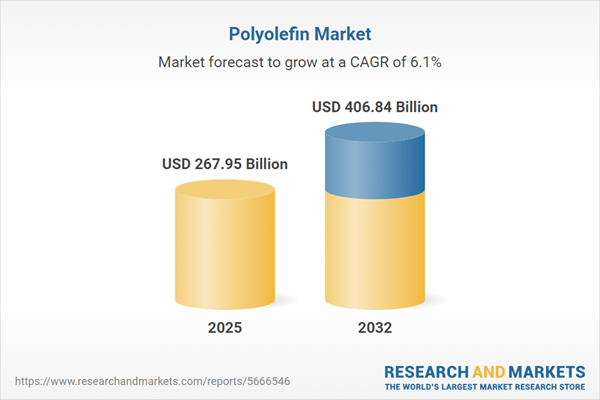Speak directly to the analyst to clarify any post sales queries you may have.
The polyolefin market is changing swiftly as senior leaders respond to evolving regulatory requirements, heightened environmental scrutiny, and the spread of digital transformation across production and supply chains. Strategic adaptation is now essential for organizations seeking to build resilience and secure growth in this competitive environment.
Market Snapshot: Polyolefin Market Size, Growth, and Industry Trends
In 2024, the global polyolefin market reached USD 253.43 billion and is expected to grow to USD 267.95 billion by 2025 and USD 406.84 billion by 2032, reflecting a compound annual growth rate of 6.09%. As end-users in automotive, construction, and packaging increase their use of polyolefin materials, this growth is spurred by a demand for high-performance, durable, and lightweight solutions. The rising focus on sustainable manufacturing, coupled with investment in new chemical recycling and advanced digital production, continues to shape procurement strategies and drive efficiency. Market participants are proactively aligning with global regulatory trends to maintain compliance and competitive advantage as industry standards evolve.
Scope & Segmentation: Core Polyolefin Market Segments
- Product Types: High-density polyethylene (HDPE), linear low-density polyethylene (LLDPE), low-density polyethylene (LDPE), and polypropylene offer adaptable solutions for stakeholders seeking application flexibility throughout industrial supply chains.
- Product Forms: Fibers, films, pipes, and sheets supply key industries with materials tailored for durability, innovation, and adherence to performance or regulatory demands.
- Production Technologies: Bulk polymerization, gas phase, slurry phase, and solution phase methods equip manufacturers to refine throughput and product consistency in response to ongoing operational needs and compliance pressures.
- Key Applications: Polyolefins are core to automotive components, construction elements, consumer goods, electronics, and packaging, supporting development suited for demanding conditions and ever-shifting user expectations.
- Regional Analysis: Opportunities differ across Americas, Europe, Asia-Pacific, and the Middle East & Africa. Regional trends require nuanced approaches to risk assessment, market entry, and regulatory alignment, often demanding locally adapted strategies.
- Company Profiles: Leading organizations such as Arkema S.A., BASF SE, Braskem S.A., ExxonMobil Corporation, and Saudi Basic Industries Corporation set benchmarks through a focus on technological upgrades and investments in sustainable product lifecycles.
Key Takeaways: Strategic Insights for Polyolefin Market Leaders
- Innovation in recycling and polymerization practices strengthens supply chain resilience and reinforces the integration of sustainability within business models.
- Deployment of digital twin solutions and data analytics gives decision-makers enhanced operational transparency and allows faster adaptation to ongoing market and customer shifts.
- Market fragmentation and regulatory variation across regions make it essential for organizations to craft region-specific sourcing and expansion strategies for sustained competitive positioning.
- Closer partnerships between manufacturers, recyclers, and technology developers are supporting circular economy initiatives while enhancing security around raw material supply.
- Growing expectations for high-performance and multifunctional applications are prompting companies to revisit product design, technology selection, and overall operating models to support versatile industry use cases.
Tariff Impact: Navigating the 2025 United States Measures
With new tariff measures anticipated in the United States from 2025, organizations are reassessing procurement and sourcing frameworks. Many are shifting toward expanding domestic production and increasing use of recycled or bio-based materials, which helps manage compliance risk and strengthen local supply networks. Strategic investment in regional manufacturing assets and local supplier collaboration is becoming necessary to maintain operational continuity and competitiveness amid regulatory change.
Methodology & Data Sources: Validating Strategic Direction
This polyolefin market analysis is based on proprietary research, interviews with senior executives, and thorough reviews of academic work and industry regulations. Each data point is validated by subject matter experts to provide actionable guidance and ensure a reliable foundation for strategic decision-making.
Why This Polyolefin Market Report Matters
- Empowers senior executives to identify regional expansion opportunities and tailor go-to-market strategies based on evolving local dynamics and compliance requirements.
- Supports operational streamlining and stronger supply chains by spotlighting relevant market trends, risk factors, and compliance issues that affect business continuity.
- Prepares leadership teams to respond rapidly to regulatory and technology disruptions, ensuring adaptability in fast-changing market settings.
Conclusion
Long-term success in the polyolefin market requires organizations to combine regulatory awareness, technology adoption, and collaborative partnerships that accelerate industry innovation while supporting resilient supply chains and business growth.
Additional Product Information:
- Purchase of this report includes 1 year online access with quarterly updates.
- This report can be updated on request. Please contact our Customer Experience team using the Ask a Question widget on our website.
Table of Contents
3. Executive Summary
4. Market Overview
7. Cumulative Impact of Artificial Intelligence 2025
Companies Mentioned
The companies profiled in this Polyolefin market report include:- Arkema S.A.
- Avient Corporation
- BASF SE
- Borealis AG
- Braskem S.A.
- Chevron Phillips Chemical Company LLC
- DOW CHEMICAL COMPANY
- Ducor Petrochemicals B.V.
- Evonik Industries AG
- ExxonMobil Corporation
- Formosa Plastics Corporation
- Hanwha Corporation
- INEOS AG
- LyondellBasell Industries Holdings B.V.
- Merck KGaA
- Mitsubishi Chemical Corporation
- NOVA Chemicals Corporation
- Reliance Industries Limited
- Repsol Group
- Saudi Arabian Oil Co.
- Saudi Basic Industries Corporation
- Shell PLC
- SK Functional Polymer Company
- The Dow Chemical Company
- Thermo Fisher Scientific Inc.
- W. R. Grace & Co.
Table Information
| Report Attribute | Details |
|---|---|
| No. of Pages | 189 |
| Published | November 2025 |
| Forecast Period | 2025 - 2032 |
| Estimated Market Value ( USD | $ 267.95 Billion |
| Forecasted Market Value ( USD | $ 406.84 Billion |
| Compound Annual Growth Rate | 6.0% |
| Regions Covered | Global |
| No. of Companies Mentioned | 27 |









